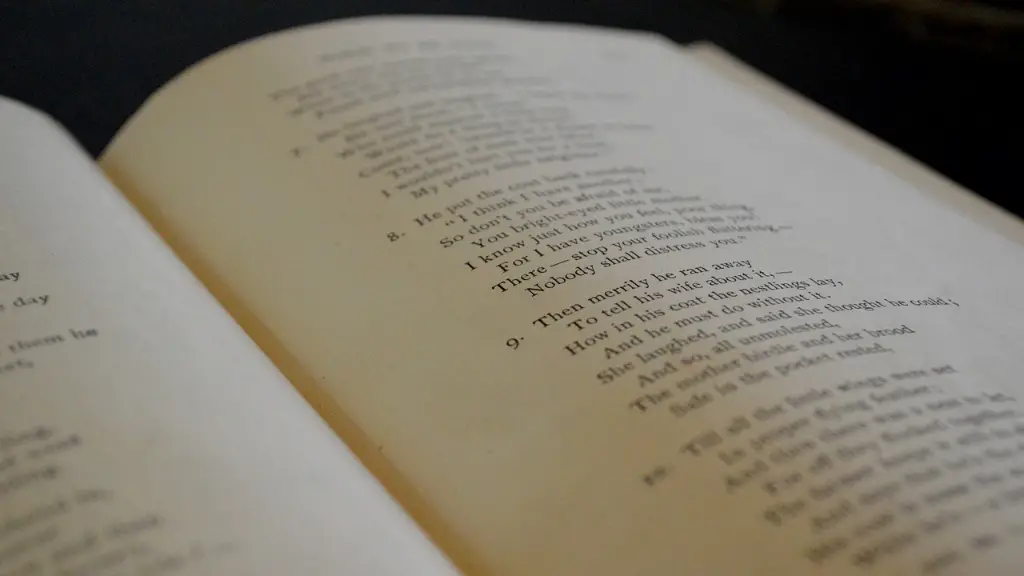Introduction
Open poetry is a form of writing with no set structure or rules. It is a place for individuals to express themselves freely, to express the words and ideas that they can’t always put into words. It’s an opportunity to paint an image and tell a story. Open poetry has roots in the classic styles of poetry, but is often seen as a vehicle for experimentation and creativity. The idea behind open poetry is to use language to explore the self and the world around us. Open poetry encourages a personal connection with the writer, creating a bridge between the artist and their audience.
Positive Perspectives On Open Poetry
Open poetry is a form of self-expression. Rather than following a set structure, it allows the poet to create their own unique style. It encourages individuals to explore their thoughts and to be mindful of their surroundings. It allows the individual to explore their emotions, to understand them and to paint an image of those emotions for the reader. Open poetry provides an outlet for the poet to express their true self in a way that can be understood and appreciated by others.
Approaches for Writing Open Poetry
When writing open poetry, it is important to have a clear idea of what you want to express. It is helpful to brainstorm ideas and have a few topics or concepts in mind before beginning the creative process. It’s important to think about the moment or experience that you want to capture in the poem. Once you have an idea in mind, begin to explore words and ideas that can be used to express that moment. Try to find the right words to articulate the emotions and moments that you are trying to evoke.
Free writing is a useful tool for crafting open poetry. Free writing involves writing about a subject without stopping for a certain amount of time. This can be a great way to capture the thoughts and emotions that come to mind when writing open poetry. It creates a space for the poet to explore their creative impulses and articulate ideas in an open and free-flowing way.
Appreciating Open Poetry
Reading and understanding open poetry can also be a creative process. It is important to keep in mind that when reading a poem, it is not always necessary to understand every word or nuance. Instead, try to appreciate the overall message or story that the poet has chosen to tell. Open poetry provides the reader with an opportunity to connect with the poet on a personal level and to appreciate the emotions and ideas portrayed in the poem.
The Benefits of Open Poetry
Open poetry can be a powerful tool for self-expression and creativity. The lack of structure gives the poet the freedom to express themselves without the boundaries of traditional poetic forms. It encourages the exploration of emotions and thoughts that can often be hard to articulate. Open poetry can be a cathartic tool for processing difficult emotions and can provide a sense of relief and release.
The Impact of Open Poetry
Open poetry has the potential to be a powerful form of communication. By expressing thoughts and emotions through words, the writer can create an image and tell a story that can be shared and understood by others. Open poetry can help people to connect and to share perspectives in a way that can be impactful and meaningful.
Pitfalls of Open Poetry
Although open poetry has many strengths, it also has weaknesses. Without structure, the risk is that the poem can become disorganized and the message can be lost. When writing open poetry, it is important to take a step back and review the poem to ensure that it is coherent and that the message still resonates.
How Open Poetry is Used in Education
Open poetry can be a powerful tool for students to express themselves and to explore ideas. It can help students to better understand themselves and the world around them. Teachers can use open poetry as a way to engage students, to encourage creative thinking, and to explore different ideas and perspectives. Open poetry can also be used to develop critical thinking skills, to promote self-reflection and to encourage collaboration.
How Open Poetry is Used in Therapy
Open poetry can be a valuable tool for those in therapy. Writing can be a way to explore difficult emotions and to process traumatic experiences. By writing open poetry, individuals can explore their feelings in a safe and creative space. Writing can help individuals to gain clarity and to see the bigger picture when dealing with difficult circumstances.
Social Applications of Open Poetry
Open poetry can also be a powerful tool for social change. Through poetry, individuals can share stories, express their visions and advocate for their causes. It can be used to inspire and to challenge the status quo. Open poetry has the ability to create empathy, to build bridges between people and to create a sense of understanding and connection.
Creating New Forms With Open Poetry
Open poetry can also be used to explore and create new forms of writing. By experimenting and pushing the boundaries of language and form, new poetic styles can be created. Open poetry can also be used in combination with visual arts and music to create unique and powerful works.
Conclusion
Open poetry is a form of writing that encourages self-expression and creativity. It is an opportunity for individuals to explore their thoughts and emotions without boundaries. Open poetry can be used to inspire, to challenge and to create meaningful connections. It is a powerful tool for self-discovery, for learning and for creating powerful art.



